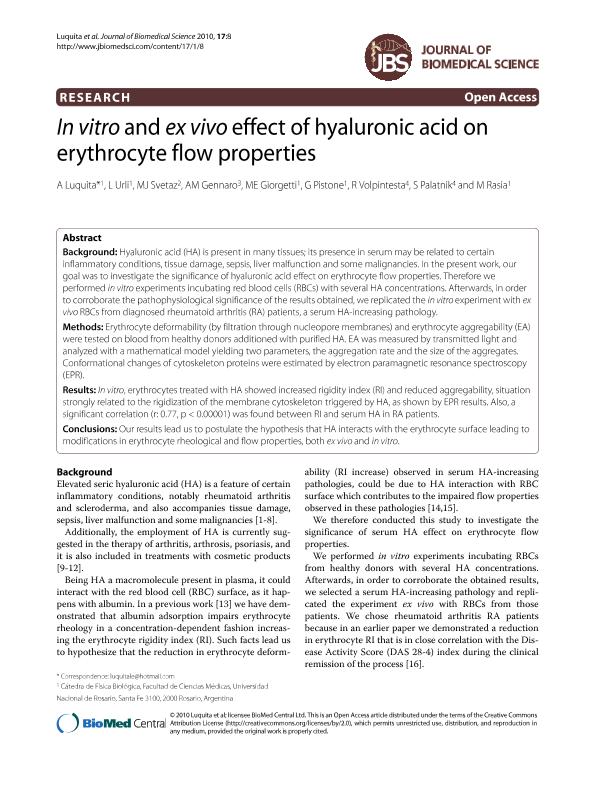Artículo
In vitro and ex vivo effect of hyaluronic acid on erythrocyte flow properties
Luquita, A.; Urli, L.; Svetaz, M. J.; Gennaro, Ana Maria ; Giorgietti, M.; Pistone, G.; Volpintesta, R.; Palatnik, S.; Rasia, M.
; Giorgietti, M.; Pistone, G.; Volpintesta, R.; Palatnik, S.; Rasia, M.
 ; Giorgietti, M.; Pistone, G.; Volpintesta, R.; Palatnik, S.; Rasia, M.
; Giorgietti, M.; Pistone, G.; Volpintesta, R.; Palatnik, S.; Rasia, M.
Fecha de publicación:
12/2010
Editorial:
Biomed Central
Revista:
Journal Of Biomedical Science
ISSN:
1021-7770
Idioma:
Inglés
Tipo de recurso:
Artículo publicado
Clasificación temática:
Resumen
Background: Hyaluronic acid (HA) is present in many tissues; its presence in serum may be related to certaininflammatory conditions, tissue damage, sepsis, liver malfunction and some malignancies. In the present work, ourgoal was to investigate the significance of hyaluronic acid effect on erythrocyte flow properties. Therefore weperformed in vitro experiments incubating red blood cells (RBCs) with several HA concentrations. Afterwards, in orderto corroborate the pathophysiological significance of the results obtained, we replicated the in vitro experiment with exvivo RBCs from diagnosed rheumatoid arthritis (RA) patients, a serum HA-increasing pathology.Methods: Erythrocyte deformability (by filtration through nucleopore membranes) and erythrocyte aggregability (EA)were tested on blood from healthy donors additioned with purified HA. EA was measured by transmitted light andanalyzed with a mathematical model yielding two parameters, the aggregation rate and the size of the aggregates.Conformational changes of cytoskeleton proteins were estimated by electron paramagnetic resonance spectroscopy(EPR).Results: In vitro, erythrocytes treated with HA showed increased rigidity index (RI) and reduced aggregability, situationstrongly related to the rigidization of the membrane cytoskeleton triggered by HA, as shown by EPR results. Also, asignificant correlation (r: 0.77, p Conclusions: Our results lead us to postulate the hypothesis that HA interacts with the erythrocyte surface leading tomodifications in erythrocyte rheological and flow properties, both ex vivo and in vitro.
Archivos asociados
Licencia
Identificadores
Colecciones
Articulos(INTEC)
Articulos de INST.DE DES.TECNOL.PARA LA IND.QUIMICA (I)
Articulos de INST.DE DES.TECNOL.PARA LA IND.QUIMICA (I)
Citación
Luquita, A.; Urli, L.; Svetaz, M. J.; Gennaro, Ana Maria; Giorgietti, M.; et al.; In vitro and ex vivo effect of hyaluronic acid on erythrocyte flow properties; Biomed Central; Journal Of Biomedical Science; 17; 12-2010; 8-14
Compartir
Altmétricas



